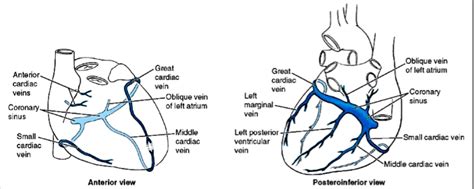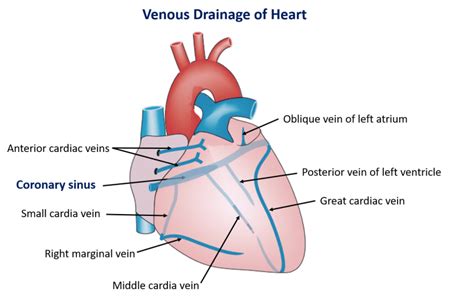Great Cardiac Vein

The Great Cardiac Vein is a vital component of the cardiac venous system, responsible for draining deoxygenated blood from the heart muscle itself. Located in the anterior interventricular groove, this vein runs alongside the left anterior descending artery and plays a crucial role in maintaining the heart's overall health and function. The Great Cardiac Vein is one of the primary tributaries of the coronary sinus, which ultimately empties into the right atrium, ensuring the efficient removal of waste products and the delivery of oxygen and nutrients to the cardiac tissue.
Key Points
- The Great Cardiac Vein is a major vein of the heart that collects deoxygenated blood from the heart muscle.
- It is located in the anterior interventricular groove and runs parallel to the left anterior descending artery.
- The Great Cardiac Vein drains into the coronary sinus, which then empties into the right atrium.
- Its role is essential for the maintenance of cardiac health and function, ensuring the removal of waste and the delivery of oxygen and nutrients.
- Understanding the anatomy and function of the Great Cardiac Vein is crucial for the diagnosis and treatment of various cardiac conditions.
Anatomical Course and Relations

The Great Cardiac Vein originates from the apex of the heart, where it commences as a small venous plexus that gradually converges into a single vessel. As it ascends, it runs in the anterior interventricular groove, closely accompanying the left anterior descending artery. This close relationship is significant, as both the artery and the vein supply and drain the anterior two-thirds of the interventricular septum and the anterior wall of the left ventricle. The Great Cardiac Vein then empties into the coronary sinus, which is located on the posterior surface of the heart, near the junction of the left atrium and the right atrium.
Clinical Significance
The clinical significance of the Great Cardiac Vein lies in its role as a conduit for cardiac venous drainage. Any obstruction or incompetence of this vein can lead to cardiac congestion and decreased cardiac output. Furthermore, the Great Cardiac Vein is often utilized in cardiac procedures such as cardiac catheterization and the placement of pacemaker leads. Understanding its anatomy is crucial for the accurate performance of these procedures, minimizing the risk of complications. For instance, during a coronary sinus catheterization, the Great Cardiac Vein serves as a landmark for the proper placement of the catheter.
| Venous Tributaries | Description |
|---|---|
| Great Cardiac Vein | Drains the anterior interventricular groove and empties into the coronary sinus. |
| Middle Cardiac Vein | Drains the posterior interventricular groove and also empties into the coronary sinus. |
| Small Cardiac Vein | Drains the right atrium and the right ventricle, often emptying into the coronary sinus or directly into the right atrium. |

Physiological Importance

The Great Cardiac Vein plays a pivotal role in the physiological maintenance of cardiac function. By efficiently draining deoxygenated blood from the heart muscle, it ensures that the myocardium receives adequate oxygenation and nutrient supply. This is particularly critical under conditions of increased cardiac workload, where the demand for oxygen and nutrients is elevated. The Great Cardiac Vein, in conjunction with the coronary sinus and other cardiac veins, forms a complex network that adapts to the heart’s changing needs, thereby maintaining optimal cardiac performance.
Pathological Considerations
Dysfunction or obstruction of the Great Cardiac Vein can have significant pathological implications. Conditions such as coronary sinus syndrome, characterized by an obstruction of the coronary sinus or its tributaries, can lead to increased pressure within the cardiac veins, resulting in cardiac congestion and potentially severe cardiac dysfunction. Understanding these pathological processes is essential for the diagnosis and management of cardiac diseases, emphasizing the need for a comprehensive approach that considers both the anatomical and physiological aspects of cardiac venous drainage.
What is the primary function of the Great Cardiac Vein?
+The primary function of the Great Cardiac Vein is to collect deoxygenated blood from the heart muscle and drain it into the coronary sinus, ultimately returning it to the right atrium for re-oxygenation.
Where is the Great Cardiac Vein located?
+The Great Cardiac Vein is located in the anterior interventricular groove of the heart, accompanying the left anterior descending artery.
What are the clinical implications of Great Cardiac Vein obstruction?
+Obstruction of the Great Cardiac Vein can lead to cardiac congestion, decreased cardiac output, and potentially severe cardiac dysfunction, emphasizing the importance of prompt diagnosis and treatment.
In conclusion, the Great Cardiac Vein is a vital component of the cardiac venous system, playing a critical role in maintaining cardiac health and function. Its anatomical course, relations, and clinical significance underscore the importance of detailed anatomical knowledge in both the diagnosis and treatment of cardiac diseases. As our understanding of cardiac anatomy and physiology continues to evolve, the recognition of the Great Cardiac Vein’s importance will remain paramount in the pursuit of optimal cardiac care.



